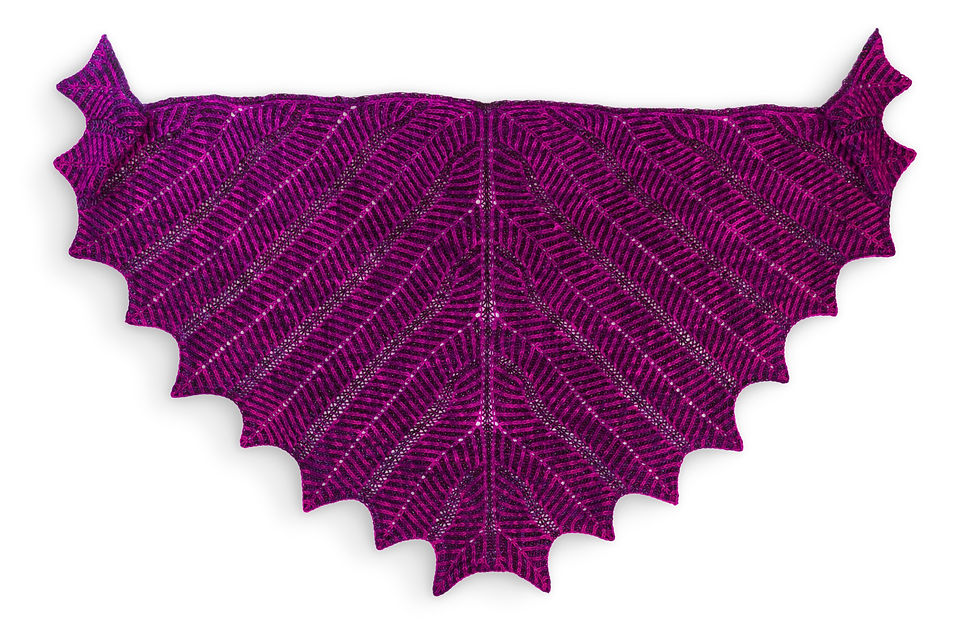Ribcage Chevron by Nancy Marchant
- hello@plinthyarn.co

- Apr 27, 2020
- 3 min read
This is Nancy Marchant’s stunning ‘Ribcage Chevron’ pattern and it is hands-down my favourite project to date. I would’ve liked to have finished it in December, but an unexpected hand injury meant I was only able to resume work on it a few weeks ago.

Brioche patterns can make some knitters feel apprehensive; jumping to the conclusion it must be complicated and beyond their level of comfort. To that, I say take a couple of deep breaths, make a cup of tea and just get stuck into it. You can do it. Once you’ve completed a repeat, stop and examine it. The value in this step can’t be overemphasised. Re-read the pattern as you’re looking at your work. See how knitting and purling the yarn overs carries the yarn on the correct side of the work? Pretty neat right?
I didn’t strictly read the pattern for most rows, but I still kept a checklist of what row and pass I was up to. I’m a sucker for paper and a pencil, and it feels good adding a tick at the end of a pass. Despite feeling comfortable with the concept of brioche knitting, I wouldn’t recommend working on this particular pattern when polite interaction with other humans is required. The suggestion to use lifelines is a good one, no matter how confident you feel to pick up incorrect stitches. Those last two sentences happen to be related. Around 28 passes worth of related. Keep this beauty for when you can relax and find your groove. I’m very happy with the choice of colours too, ‘Hyper Orchid’ and ‘Plum’.
I didn’t prepare a swatch for this pattern and I don’t tend to for shawls and scarves. I realise I’m breaking a golden rule, but it genuinely doesn’t bother me if they end up a bit larger or smaller than the specifications. As I knit I’m conscious that the machine-washable merino I use will grow once wet, so I kind of eyeball it as I work and use reasonable judgment if things are moving in the right direction. But for EVERY other garment project, I am firmly with Camp Swatch.

When I bound off this shawl, the length measured 21 inches (53cms). Without being too aggressive, the magic of blocking then opened it up to a final, dry, 27 inches (68cm). The way the ribcages flourished when wet made for a very happy Sunday.

I used a conventional k1, p1 bind off with a lightly tensioned hand, and I’m happy with the way it gives a vivid, pink outline to the lower edge of the shawl. I was second guessing myself whether instead I should’ve done an Italian bind off. That would have given some variation between the pink and purple as per the top edge of the shawl. After some time thinking about it I’m equally happy with how it would’ve turned out either way.

The reverse side is nice enough, but I think once you’ve chosen your favourite colour as the main for the front, the reverse won’t wow you more than the front. If you choose to drape the shawl like a scarf around your neck, some of the exposed underside will beautifully contrast the main side though.
All in all, I used 267 grams of 4 ply yarn; a large (100g) and a small (50g) skein of each colour.
I love the versatility of shawls. In winter we should all have one tucked in our bags. The comfort of draping a handmade, warm fabric around your shoulders makes the time investment deeply satisfying. Being able to wrap up a chilly friend or the little humans in your life is a reward beyond compare.
If you’re considering making this shawl, you have my complete encouragement. Take your time and enjoy the process. I’m sure you’ll love your finished shawl every bit as much as I do mine.
The ‘Ribcage Chevron’ pattern can be found at:
xxx







Comments